Interaction of Soil Nutrients and Arsenic (As) in Paddy Soil in a Long-Term Fertility Experiment
Abstract
1. Introduction
2. Materials and Methods
2.1. Experimental Site
2.2. Experimental Setup and Crop Management
2.3. Sampling and Chemical Analysis
2.4. Calculations
2.5. Data Analysis Tools
3. Results
3.1. Long-Term Fertilization Impact on Soil Characteristics
3.2. Annual Rice Crop Yield and Bioaccumulation of Arsenic in Grain
3.3. Correlations between Bioaccumulation Coefficient of Arsenic and Soil Properties
4. Discussion
5. Conclusions
Author Contributions
Funding
Institutional Review Board Statement
Informed Consent Statement
Conflicts of Interest
References
- Mahroz, M.; Bibi, I.; Khan, N.; Shahid, M.; Iqbal, J.; Bilal, M.; Ahmad, A.; Samad, N.; Bhattacharya, P.; Mao, K. Arsenic biogeochemical cycling in paddy soil-rice system: Interaction with various factors, amendments and mineral nutrients. Sci. Total Environ. 2021, 773, 145040. [Google Scholar] [CrossRef]
- Thounaojam, T.C.; Khan, Z.; Upadhyaya, H. Molecular physiology of arsenic uptake, transport, and metabolism in rice. In Arsenic in Drinking Water and Food; Springer: New York, NY, USA, 2020; pp. 391–410. [Google Scholar]
- Polizzotto, M.K.; Lineberger, E.M.; Matteson, A.R.; Neumann, R.B.; Badruzzaman, A.B.M.; Ali, M.A. Arsenic transport in irrigation water across rice-field soils in Bangladesh. Environ. Pollut. 2013, 179, 210–217. [Google Scholar] [CrossRef] [PubMed]
- Hussain, S.; Rengel, Z.; Qaswar, M.; Amir, M.; Zafar-Ul-Hye, M. Arsenic and heavy metal (cadmium, lead, mercury and nickel) contamination in plant-based foods. In Plant and Human Health; Munir Ozturk, K.R.H., Ed.; Springer: New York, NY, USA, 2019; pp. 447–490. [Google Scholar]
- Hsu, W.M.; Hsi, H.C.; Huang, Y.T.; Liao, C.S.; Hseu, Z.Y. Partitioning of arsenic in soil-crop systems irrigated using groundwater: A case study of rice paddy soils in southwestern Taiwan. Chemosphere 2012, 86, 606–613. [Google Scholar] [CrossRef]
- Carrijo, D.R.; Li, C.; Parikh, S.J.; Linguist, B.A. Irrigation management for arsenic mitigation in rice grain: Timing and severity of a single soil drying. Sci. Total Environ. 2018, 649, 300–307. [Google Scholar] [CrossRef] [PubMed]
- Kumarathilaka, P.; Seneweera, S.; Meharg, A.; Bundschuh, J. Arsenic speciation dynamics in paddy rice soil-water environment: Sources, physico-chemical, and biological factors—A review. Water Res. 2018, 140, 403–414. [Google Scholar] [CrossRef] [PubMed]
- WHO. Guidelines for Drinking-Water Quality; World Health Organization: Geneva, Switzerland, 2011; pp. 315–318.
- Codex Alimentarius Commission. General Standard for Contaminants and Toxins in Food and Feed; Food and Agriculture Organization: Rome, Italy; World Health Organization: Geneva, Switzerland, 2016.
- Laborte, A.G.; Gutierrez, M.A.; Balanza, J.G.; Saito, K.; Zwart, S.J.; Boschetti, M.; Murty, M.V.R.; Villano, L.; Aunario, J.K.; Reinke, R. RiceAtlas, a spatial database of global rice calendars and production. Sci. Data 2017, 4, 170074. [Google Scholar] [CrossRef]
- Tang, X.; Zou, L.; Su, S.; Lu, Y.; Zhai, W.; Manzoor, M.; Liao, Y.; Nie, J.; Shi, J.; Ma, L.Q.; et al. Long-term manure application changes bacterial communities in rice rhizosphere and arsenic speciation in rice grains. Environ. Sci. Technol. 2021, 55, 1555–1565. [Google Scholar] [CrossRef]
- Suriyagoda, L.D.B.; Dittert, K.; Lambers, H. Mechanism of arsenic uptake, translocation and plant resistance to accumulate arsenic in rice grains. Agric. Ecosyst. Environ. 2018, 253, 23–37. [Google Scholar] [CrossRef]
- Yang, X.; Li, Q.; Tang, Z.; Zhang, W.; Yu, G.; Shen, Q.; Zhao, F. Heavy metal concentrations and arsenic speciation in animal manure composts in China. Waste Manag. 2017, 64, 333–339. [Google Scholar] [CrossRef]
- Islam, S.; Rahman, M.M.; Islam, M.R.; Naidu, R. Effect of irrigation and genotypes towards reduction in arsenic load in rice. Sci. Total Environ. 2017, 609, 311–318. [Google Scholar] [CrossRef]
- Zhao, K.; Liu, X.; Xu, J.; Selim, H.M. Heavy metal contaminations in a soil-rice system: Identification of spatial dependence in relation to soil properties of paddy fields. J. Hazard. Mater. 2010, 181, 778–787. [Google Scholar] [CrossRef] [PubMed]
- Kumarathilaka, P.; Seneweera, S.; Ok, Y.S.; Meharg, A.A.; Bundschuh, J. Mitigation of arsenic accumulation in rice: An agronomical, physico-chemical, and biological approach—A critical review. Crit. Rev. Environ. Sci. Technol. 2019, 50, 31–71. [Google Scholar] [CrossRef]
- Abbas, G.; Murtaza, B.; Bibi, I.; Shahid, M.; Natasha. Arsenic uptake, toxicity, detoxification, and speciation in plants: Physiological, biochemical, and molecular aspects. Int. J. Environ. Res. Public Health 2018, 15, 59. [Google Scholar] [CrossRef]
- Honma, T.; Ohba, H.; Kaneko, A.; Nakamura, K.; Makino, T.; Katou, H. Effects of soil amendments on arsenic and cadmium uptake by rice plants (Oryza sativa L. cv. Koshihikari) under different water management practices. Soil Sci. Plant Nutr. 2016, 62, 349–356. [Google Scholar] [CrossRef]
- Zia, Z.; Bakhat, H.F.; Saqib, Z.A.; Shah, G.M.; Fahad, S.; Ashraf, M.R.; Hammad, H.M.; Naseem, W.; Shahid, M. Effect of water management and silicon on germination, growth, phosphorus and arsenic uptake in rice. Ecotoxicol. Environ. Saf. 2017, 144, 11–18. [Google Scholar] [CrossRef] [PubMed]
- Qaswar, M.; Yiren, L.; Jing, H.; Kaillou, L.; Mudasir, M.; Zhenzhen, L.; Hongqian, H.; Xianjin, L.; Jianhua, J.; Ahmed, W.; et al. Soil nutrients and heavy metal availability under long-term combined application of swine manure and synthetic fertilizers in acidic paddy soil. J. Soils Sediments 2020, 20, 2093–2106. [Google Scholar] [CrossRef]
- Bogdan, K.; Schenk, M.K. Evaluation of soil characteristics potentially affecting arsenic concentration in paddy rice (Oryza sativa L.). Environ. Pollut. 2009, 157, 2617–2621. [Google Scholar] [CrossRef]
- Anawar, H.M.; Rengel, Z.; Damon, P.; Tibbett, M. Arsenic-phosphorus interactions in the soil-plant-microbe system: Dynamics of uptake, suppression and toxicity to plants. Environ. Pollut. 2018, 233, 1003–1012. [Google Scholar] [CrossRef]
- IUSS. World Reference Base for Soil Resources 2014, Update 2015. International Soil Classification System for Naming Soils and Creating Legends for Soil Maps. World Soil Resources Reports No. 106; IUSS Working Group WRB: Vienna, Austria, 2015. [Google Scholar]
- Page, A.L. (Ed.) Methods of Soil Analysis: Part 2. Chemical Methods; Soil Science Society of America Inc.: Madison, WI, USA, 1982. [Google Scholar]
- Black, C.A. Methods of Soil Analysis Part II. Chemical and Microbiological Properties; American Society of Agriculture: Madison, WI, USA, 1965. [Google Scholar]
- Murphy, J.; Riley, J.P. A modified single solution method for the determination of phosphate in natural waters. Anal. Chim. Acta 1964, 27, 31–36. [Google Scholar] [CrossRef]
- Lu, R.K. Analytical Methods of Soil Agricultural Chemistry; China Agricultural Science and Technology Press: Beijing, China, 2000. [Google Scholar]
- Olsen, S.R. Estimation of Available Phosphorus in Soils by Extraction with Sodium Bicarbonate; U.S. Department of Agriculture: Washington, DC, USA, 1954.
- Houba, V.J.G.; Temminghoff, E.J.M.; Gaikhorst, G.A.; Vark, W. Van calcium chloride as extraction reagent. Commun. Soil Sci. Plant Anal. 2000, 31, 1299–1396. [Google Scholar] [CrossRef]
- Li, Y.; Chen, T. Concentrations of additive arsenic in Beijing pig feeds and the residues in pig manure. Resour. Conserv. Recycl. 2005, 45, 356–367. [Google Scholar] [CrossRef]
- Xiao, R.; Wang, S.; Li, R.; Wang, J.J.; Zhang, Z. Soil heavy metal contamination and health risks associated with artisanal gold mining in Tongguan, Shaanxi, China. Ecotoxicol. Environ. Saf. 2017, 141, 17–24. [Google Scholar] [CrossRef]
- Steel, R.G.D.; Torrie, J.H.; Dickey, D.A. Principles and Procedures of Statistics: A Biological Approach; McGraw-Hill: New York, NY, USA, 1997. [Google Scholar]
- Heuer, H.; Schmitt, H.; Smalla, K. Antibiotic resistance gene spread due to manure application on agricultural fields. Curr. Opin. Microbiol. 2011, 14, 236–243. [Google Scholar] [CrossRef]
- Cai, A.; Xu, M.; Wang, B.; Zhang, W.; Liang, G.; Hou, E.; Luo, Y. Manure acts as a better fertilizer for increasing crop yields than synthetic fertilizer does by improving soil fertility. Soil Tillage Res. 2019, 189, 168–175. [Google Scholar] [CrossRef]
- Singh, R.J.; Ghosh, B.N.; Sharma, N.K.; Patra, S.; Dadhwal, K.S.; Meena, V.S.; Deshwal, J.S.; Mishra, P.K. Effect of seven years of nutrient supplementation through organic and inorganic sources on productivity, soil and water conservation, and soil fertility changes of maize-wheat rotation in north-western Indian Himalayas. Agric. Ecosyst. Environ. 2017, 249, 177–186. [Google Scholar] [CrossRef]
- Ur Rahim, H.; Mian, I.A.; Arif, M.; Ahmad, S.; Khan, Z. Soil fertility status as influenced by the carryover effect of biochar and summer legumes. Asian J. Agric. Biol. 2020, 8, 11–16. [Google Scholar] [CrossRef]
- Chen, F.F.; Zhang, C.S.; Wang, Y.N.; Qiu, H.G. Patterns and cost-benefit analysis of manure disposal of scale pig production in China. China Environ. Sci. 2017, 37, 3455–3463. [Google Scholar]
- Qian, X.; Shen, G.; Yao, Z.; Guo, C.; Xu, S.; Wang, Z. Town-based spatial heterogeneity of nutrient balance and potential pollution risk of land application of animal manure and fertilizer in Shanghai, China. Nutr. Cycl. Agroecosyst. 2012, 92, 67–77. [Google Scholar] [CrossRef]
- Wang, H.; Dong, Y.; Yang, Y.; Toor, G.S.; Zhang, X. Changes in heavy metal contents in animal feeds and manures in an intensive animal production region of China. J. Environ. Sci. 2013, 25, 2435–2442. [Google Scholar] [CrossRef]
- Alvarenga, P.; Mourinha, C.; Farto, M.; Santos, T.; Palma, P.; Sengo, J.; Morais, M.; Cunha-queda, C. Sewage sludge, compost and other representative organic wastes as agricultural soil amendments: Benefits versus limiting factors. Waste Manag. 2015, 40, 44–52. [Google Scholar] [CrossRef]
- Cai, Z.; Xu, M.; Wang, B.; Zhang, L.; Wen, S.; Gao, S. Effectiveness of crop straws, and swine manure in ameliorating acidic red soils: A laboratory study. J. Soils Sediments 2018, 18, 2893–2903. [Google Scholar] [CrossRef]
- Zhang, W.; Xu, M.; Wang, X.; Huang, Q.; Nie, J.; Li, Z.; Li, S.; Hwang, S.W.; Lee, K.B. Effects of organic amendments on soil carbon sequestration in paddy fields of subtropical China. J. Soils Sediments 2012, 12, 457–470. [Google Scholar] [CrossRef]
- Qaswar, M.; Jing, H.; Ahmed, W.; Dongchu, L.; Shujun, L.; Lu, Z.; Cai, A.; Lisheng, L.; Yongmei, X.; Jusheng, G.; et al. Yield sustainability, soil organic carbon sequestration and nutrients balance under long-term combined application of manure and inorganic fertilizers in acidic paddy soil. Soil Tillage Res. 2020, 198, 104569. [Google Scholar] [CrossRef]
- Stark, C.; Condron, L.M.; Stewart, A.; Di, H.J.; O’Callaghan, M. Influence of organic and mineral amendments on microbial soil properties and processes. Appl. Soil Ecol. 2007, 35, 79–93. [Google Scholar] [CrossRef]
- Xu, J.M.; Tang, C.; Chen, Z.L. The role of plant residues in pH change of acid soils differing in initial pH. Soil Biol. Biochem. 2006, 38, 709–719. [Google Scholar] [CrossRef]
- Tirol-Padre, A.; Ladha, J.K.; Regmi, A.P.; Bhandari, A.L.; Inubushi, K. Organic amendments affect soil parameters in two long-term rice-wheat experiments. Soil Sci. Soc. Am. J. 2007, 71, 442. [Google Scholar] [CrossRef]
- Qaswar, M.; Chai, R.; Ahmed, W.; Jing, H.; Han, T.; Liu, K.; Ye, X.; Xu, Y.; Anthonio, C.K.; Zhang, H. Partial substitution of chemical fertilizers with organic amendments increased rice yield by changing phosphorus fractions and improving phosphatase activities in fluvo-aquic soil. J. Soils Sediments 2020, 20, 1285–1296. [Google Scholar] [CrossRef]
- Zhong, W.H.; Cai, Z.C. Long-term effects of inorganic fertilizers on microbial biomass and community functional diversity in a paddy soil derived from quaternary red clay. Appl. Soil Ecol. 2007, 36, 84–91. [Google Scholar] [CrossRef]
- Demelash, N.; Bayu, W.; Tesfaye, S.; Ziadat, F.; Sommer, R. Current and residual effects of compost and inorganic fertilizer on wheat and soil chemical properties. Nutr. Cycl. Agroecosyst. 2014, 100, 357–367. [Google Scholar] [CrossRef]
- Tadesse, T.; Dechassa, N.; Bayu, W.; Gebeyehu, S. Effects of farmyard manure and inorganic fertilizer application on soil physico-chemical properties and nutrient balance in rain-fed lowland rice ecosystem. Am. J. Plant Sci. 2013, 4, 309–316. [Google Scholar] [CrossRef]
- Li, C.; Yan, K.; Tang, L.; Jia, Z.; Li, Y. Change in deep soil microbial communities due to long-term fertilization. Soil Biol. Biochem. 2014, 75, 264–272. [Google Scholar] [CrossRef]
- Wang, M.; Liu, R.; Lu, X.; Zhu, Z.; Wang, H.; Jiang, L.; Liu, J.; Wu, Z. Heavy metal contamination and ecological risk assessment of swine manure irrigated vegetable soils in Jiangxi Province, China. Bull. Environ. Contam. Toxicol. 2018, 100, 634–640. [Google Scholar] [CrossRef]
- Rowland, H.; Boothman, C.; Pancost, R.; Gault, A.; Polya, D.; Lloyd, J.R. The role of indigenous microorganisms in the biodegradation of naturally occurring petroleum, the reduction of iron, and the mobilization of arsenite from west bengal aquifer sediments. J. Environ. Qual. 2009, 38, 1598–1607. [Google Scholar] [CrossRef]
- Zhang, L.; Qin, X.; Tang, J.; Liu, W.; Yang, H. Review of arsenic geochemical characteristics and its significance on arsenic pollution studies in karst groundwater, Southwest China. Appl. Geochem. 2017, 77, 80–88. [Google Scholar] [CrossRef]
- Mladenov, N.; Zheng, Y.; Simone, B.; Bilinski, T.M.; McKnight, D.; Nemergut, D.; Radloff, K.; Rahman, M.M.; Ahmed, K. Dissolved organic matter quality in a shallow aquifer of Bangladesh: Implications for arsenic mobility. Environ. Sci. Technol. 2015, 49, 10815–10824. [Google Scholar] [CrossRef]
- Gerdelidani, A.F.; Towfighi, H.; Shahbazi, K.; Lamb, D.T.; Choppala, G.; Abbasi, S.; Bari, A.S.M.F.; Naidu, R.; Rahman, M.M. Arsenic geochemistry and mineralogy as a function of particle-size in naturally arsenic-enriched soils. J. Hazard. Mater. 2021, 403, 123931. [Google Scholar] [CrossRef]
- Bindraban, P.S.; Dimkpa, C.O.; Pandey, R. Exploring phosphorus fertilizers and fertilization strategies for improved human and environmental health. Biol. Fertil. Soils 2020, 56, 299–317. [Google Scholar] [CrossRef]
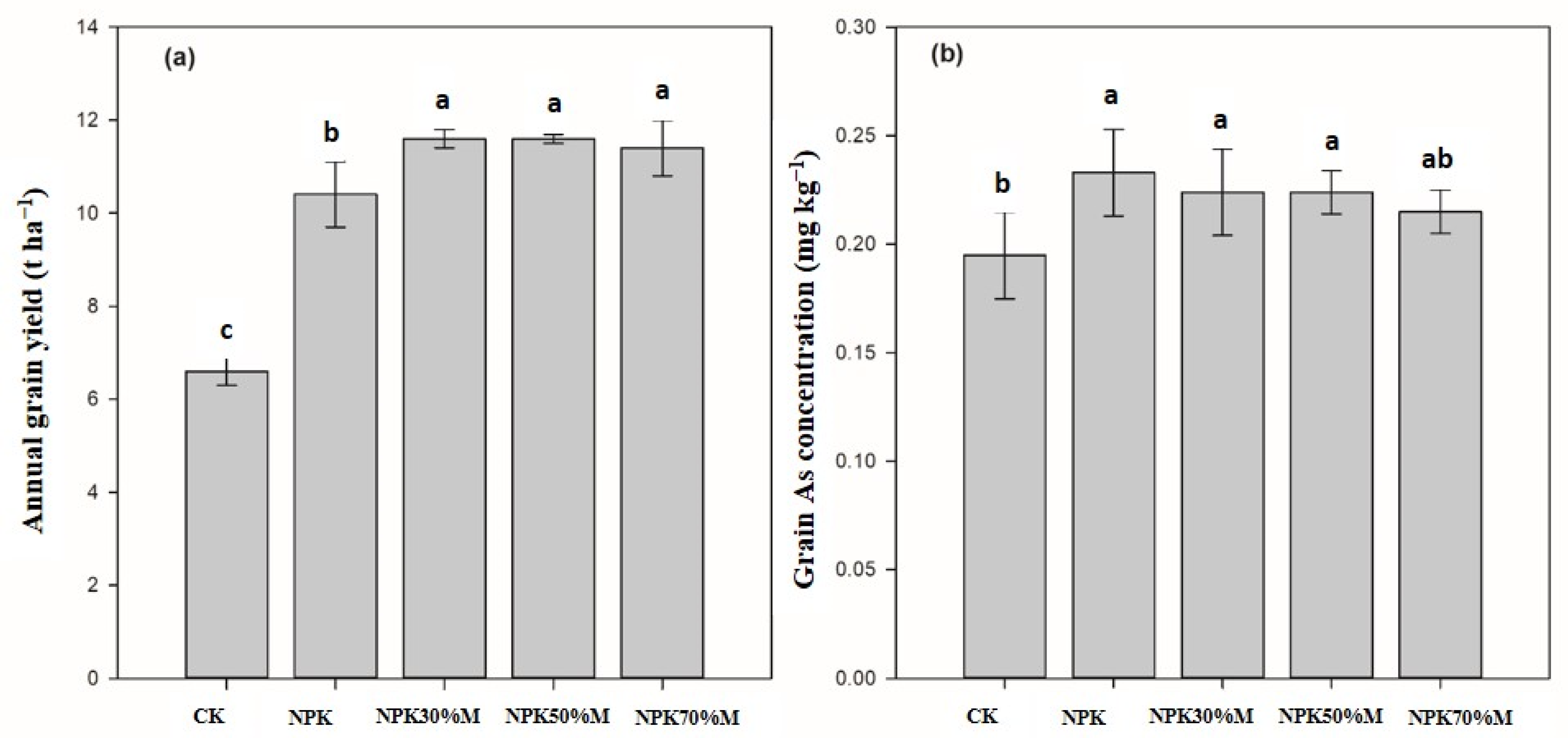
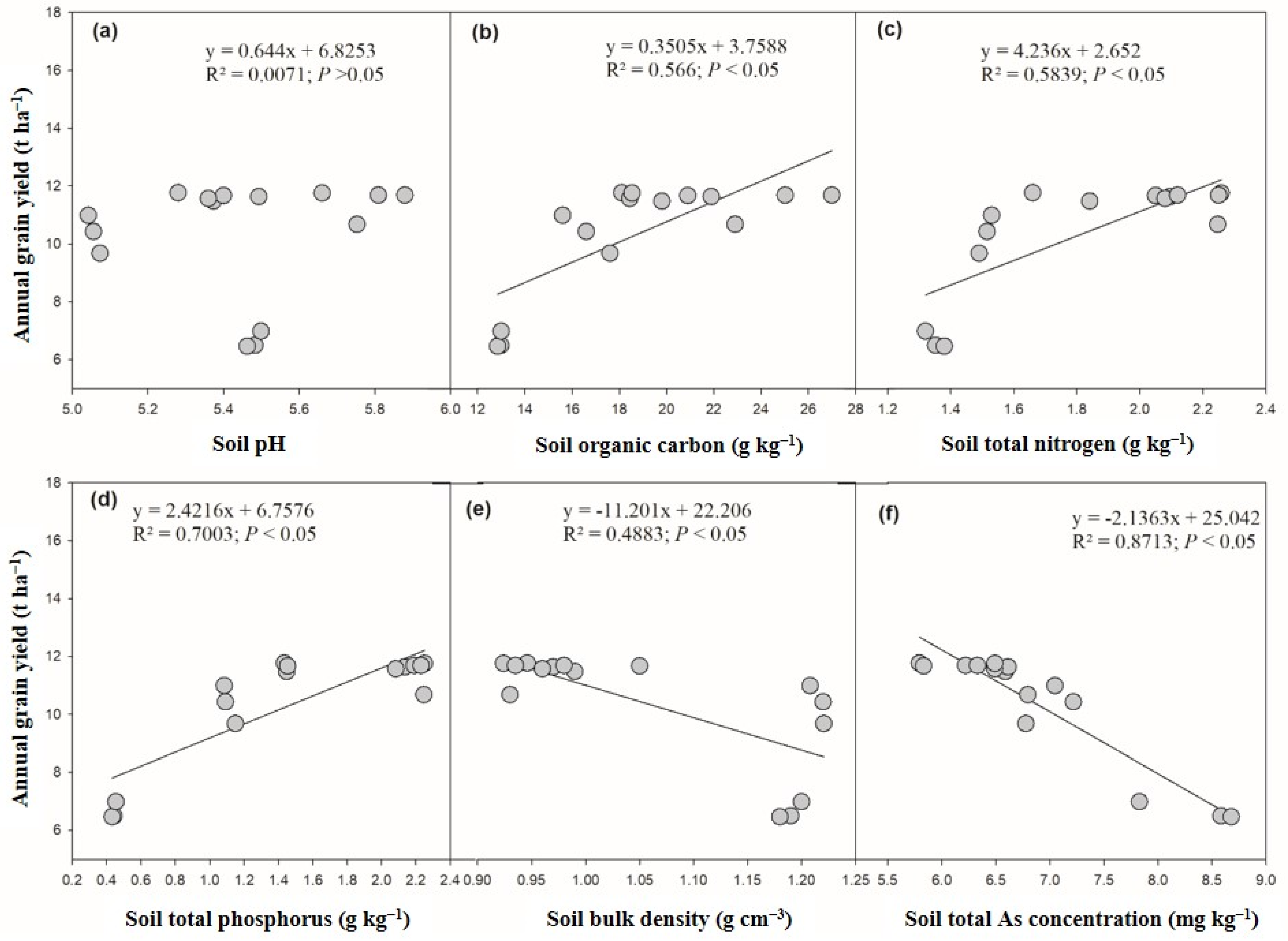
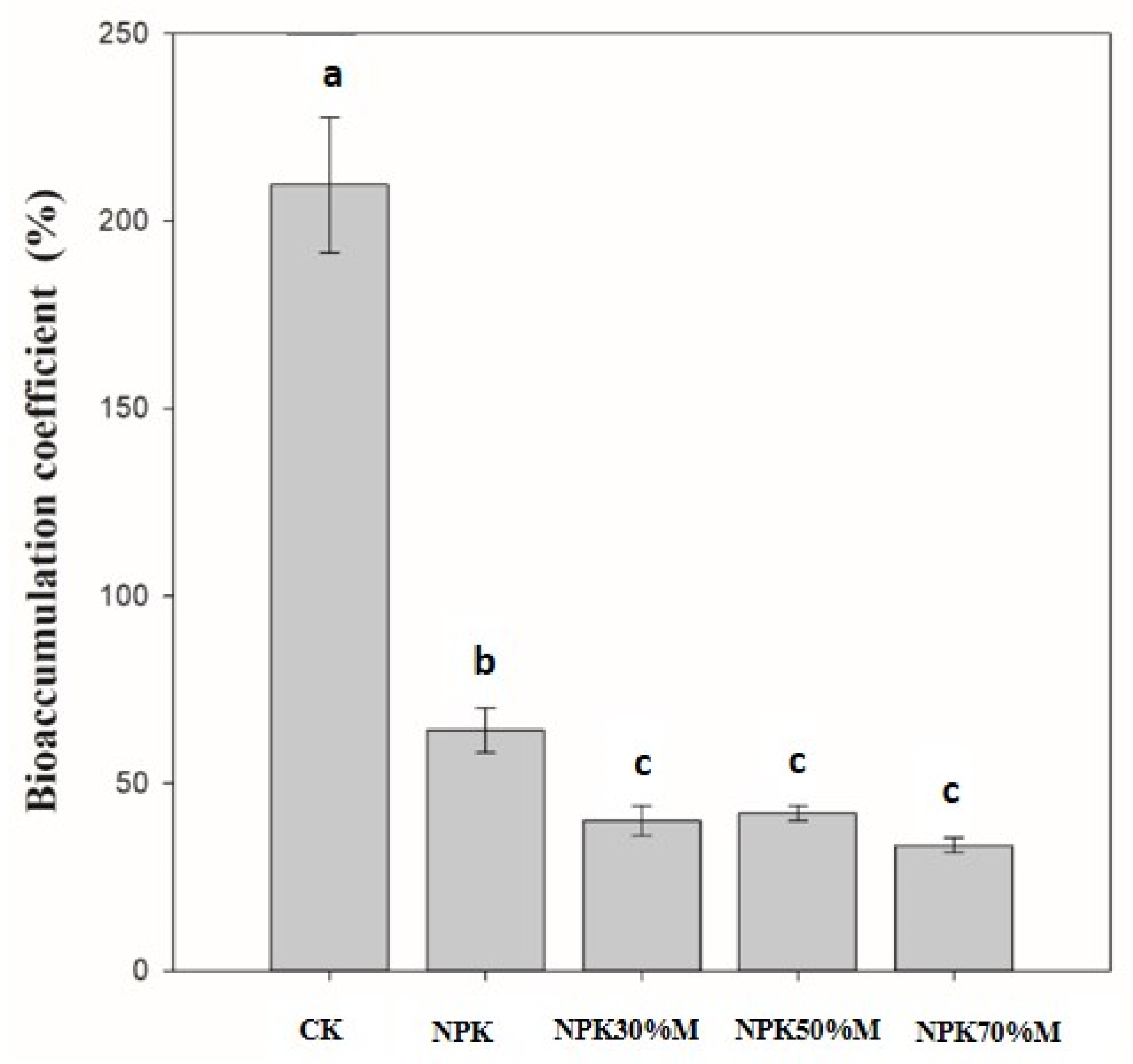
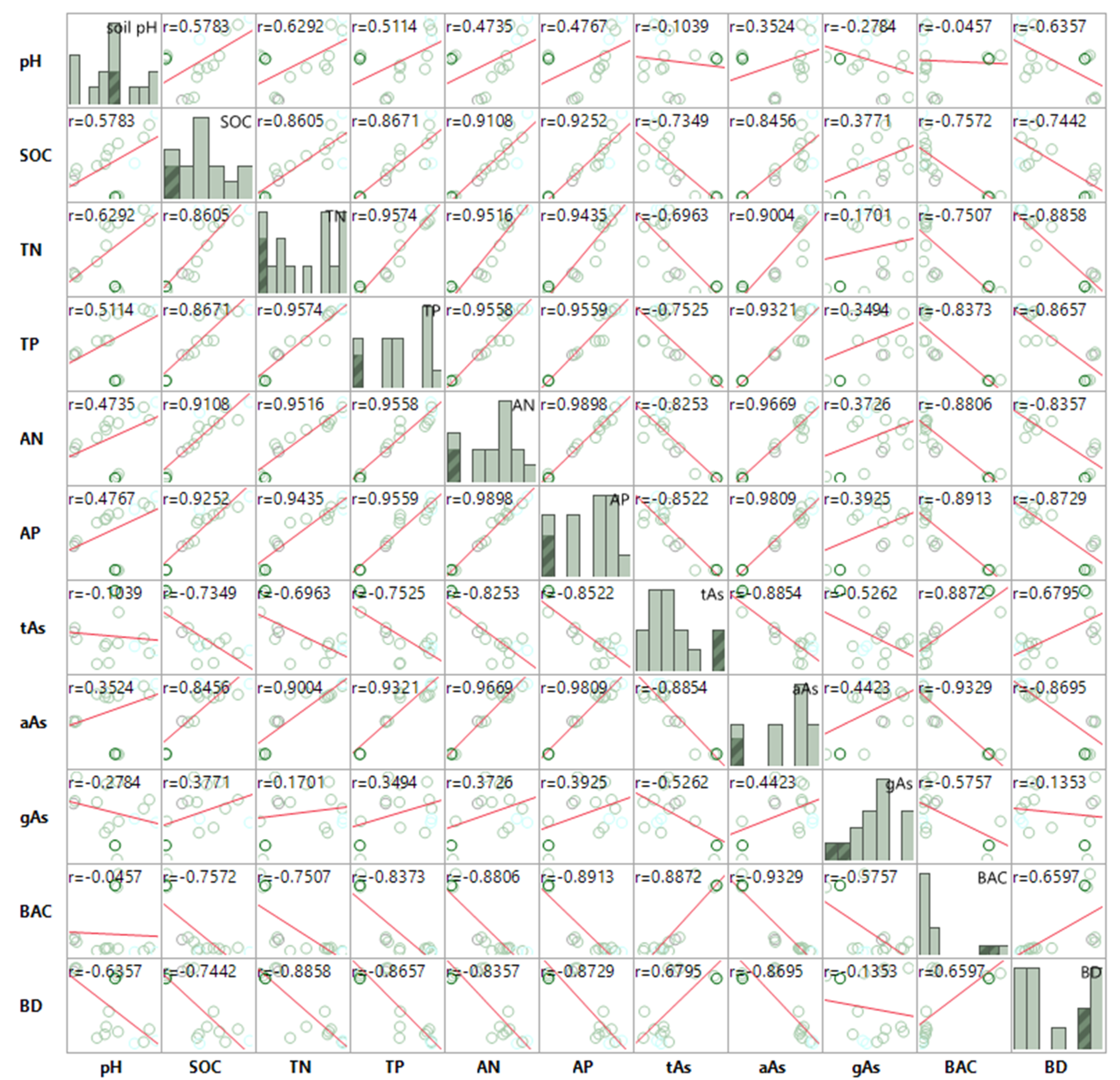
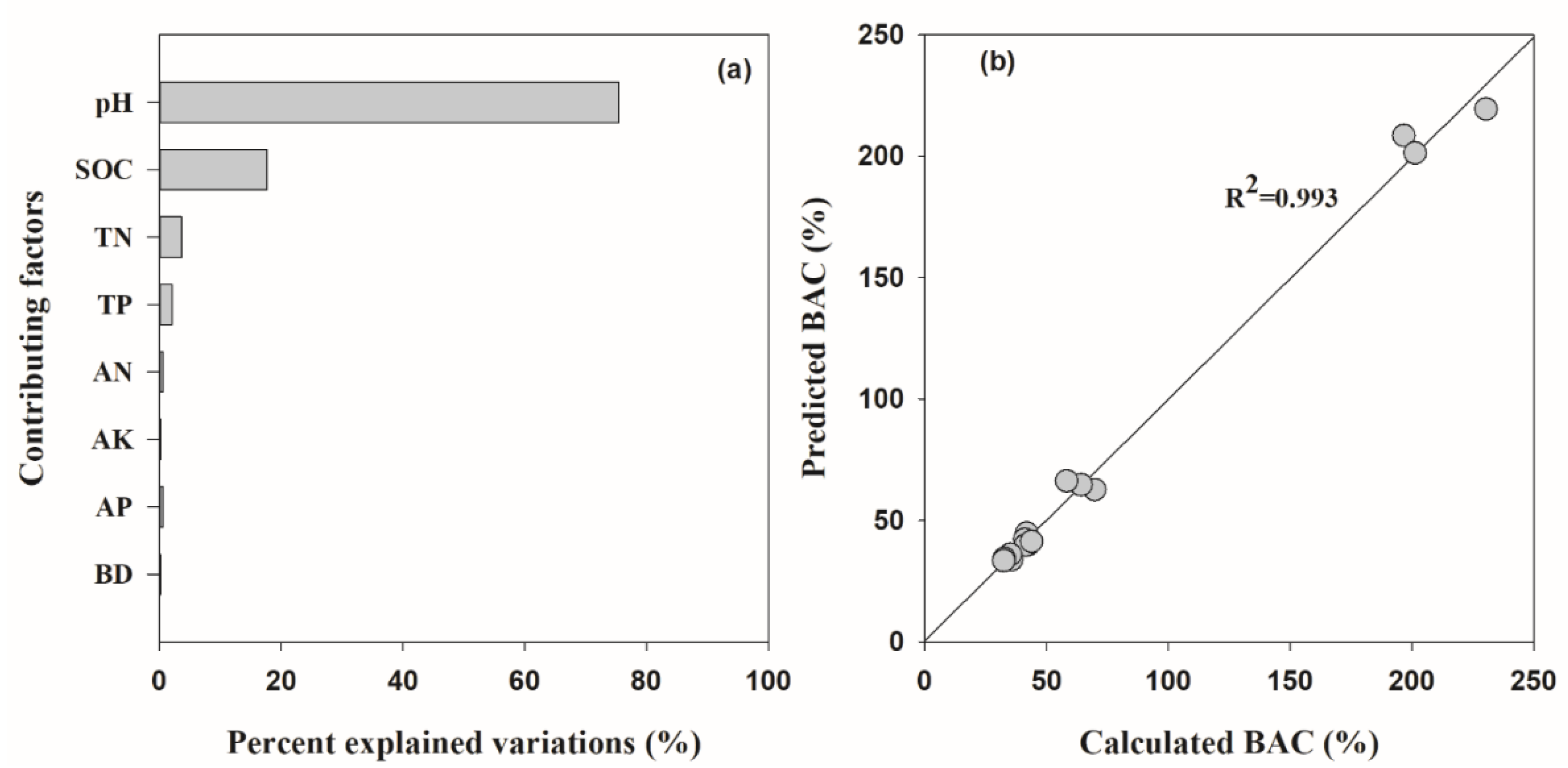
| Treatments * | pH | SOC (g kg−1) | TN (g kg−1) | TP (g kg−1) | AN (mg kg−1) | AP (mg kg−1) | tAs (mg kg−1) | aAs (mg kg−1) | Soil BD (g cm−3) |
|---|---|---|---|---|---|---|---|---|---|
| CK | 5.48 ± 0.02 b | 12.94 ± 0.08 c | 1.35 ± 0.03 c | 0.44 ± 0.01 e | 89.79 ± 3.44 d | 10.82 ± 0.40 d | 8.36 ± 0.47 a | 0.09 ± 0.002 d | 1.19 ± 0.01 a |
| NPK | 5.06 ± 0.02 c | 16.60 ± 1.00 bc | 1.51 ± 0.02 c | 1.11 ± 0.04 d | 134.23 ± 6.05 c | 52.65 ± 4.12 c | 7.01 ± 0.22 b | 0.35 ± 0.01 c | 1.22 ± 0.01 a |
| NPK30%M | 5.35 ± 0.06 b | 19.60 ± 1.41 ab | 1.85 ± 0.20 b | 1.45 ± 0.05 c | 163.35 ± 12.90 b | 91.44 ± 6.05 b | 6.07 ± 0.45 c | 0.56 ± 0.02 b | 1.00 ± 0.05 b |
| NPK50%M | 5.55 ± 0.23 ab | 21.78 ± 3.29 a | 2.10 ± 0.02 a | 2.14 ± 0.01 b | 173.39 ± 5.01 b | 100.32 ± 9.95 b | 6.44 ± 0.20 bc | 0.55 ± 0.01 b | 0.97 ± 0.01 bc |
| NPK70%M | 5.76 ± 0.11 a | 22.81 ± 4.23 a | 2.25 ± 0.01 a | 2.24 ± 0.01 a | 198.33 ± 8.20 a | 116.38 ± 10.1 a | 6.54 ± 0.24 bc | 0.64 ± 0.01 a | 0.93 ± 0.01 c |
Publisher’s Note: MDPI stays neutral with regard to jurisdictional claims in published maps and institutional affiliations. |
© 2022 by the authors. Licensee MDPI, Basel, Switzerland. This article is an open access article distributed under the terms and conditions of the Creative Commons Attribution (CC BY) license (https://creativecommons.org/licenses/by/4.0/).
Share and Cite
Qaswar, M.; Yiren, L.; Liu, K.; Zhenzhen, L.; Hongqian, H.; Lan, X.; Jianhua, J.; Ahmed, W.; Lisheng, L.; Mouazen, A.M.; et al. Interaction of Soil Nutrients and Arsenic (As) in Paddy Soil in a Long-Term Fertility Experiment. Sustainability 2022, 14, 11939. https://doi.org/10.3390/su141911939
Qaswar M, Yiren L, Liu K, Zhenzhen L, Hongqian H, Lan X, Jianhua J, Ahmed W, Lisheng L, Mouazen AM, et al. Interaction of Soil Nutrients and Arsenic (As) in Paddy Soil in a Long-Term Fertility Experiment. Sustainability. 2022; 14(19):11939. https://doi.org/10.3390/su141911939
Chicago/Turabian StyleQaswar, Muhammad, Liu Yiren, Kailou Liu, Lv Zhenzhen, Hou Hongqian, Xianjin Lan, Ji Jianhua, Waqas Ahmed, Liu Lisheng, Abdul M. Mouazen, and et al. 2022. "Interaction of Soil Nutrients and Arsenic (As) in Paddy Soil in a Long-Term Fertility Experiment" Sustainability 14, no. 19: 11939. https://doi.org/10.3390/su141911939
APA StyleQaswar, M., Yiren, L., Liu, K., Zhenzhen, L., Hongqian, H., Lan, X., Jianhua, J., Ahmed, W., Lisheng, L., Mouazen, A. M., & Huimin, Z. (2022). Interaction of Soil Nutrients and Arsenic (As) in Paddy Soil in a Long-Term Fertility Experiment. Sustainability, 14(19), 11939. https://doi.org/10.3390/su141911939







